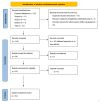Current Overview of Environmental Disinfection and Decolonization of C. auris: A Systematic Review from 2020 to 2025
- PMID: 40559722
- PMCID: PMC12197617
- DOI: 10.3390/tropicalmed10060155
Current Overview of Environmental Disinfection and Decolonization of C. auris: A Systematic Review from 2020 to 2025
Abstract
Candida auris possesses distinctive features that facilitate its persistence and transmission in healthcare settings, causing outbreaks of infection that are difficult to treat. So, emphasis has been placed on implementing measures for controlling, eliminating, and preventing fungal transmission, such as environmental disinfection and patient decolonization. This review aimed to understand and analyze the agents for environmental disinfection and patient decolonization reported in the last 5 years. The PubMed database was reviewed, using the terms "Candida auris", "disinfection", and "decolonization". Only original papers, published between 2020-2025, in English or Spanish, that included relevant information on the topic, were selected. After the selection process, 52 articles were chosen to analyze the agents for environmental disinfection and decolonization of C. auris. Natural and synthetic disinfectants and ultraviolet radiation were reported for the environmental disinfection, with variable efficacy, depending on factors such as concentration and exposure time. Natural and synthetic antiseptics were also reported for decolonization, with varying efficacy. For example, 2% chlorhexidine shows a 0.5 log reduction, while at concentrations >10% it is >4 log. However, most have only been tested in animal models. Based on the review, Far-UV-C radiation (222 nm) is safe and appropriate to mitigate (up to 1 log reduction) the spread of C. auris in the hospital setting. However, it is important to consider that the cost and limited availability of the device present a barrier to its implementation. Patient decolonization is still challenging nowadays due to the absence of agents with proven high efficacy in humans.
Keywords: candidiasis; far UV-C; outbreak control; propagation.
Conflict of interest statement
The authors declare no conflicts of interest.
Figures
Similar articles
-
Home treatment for mental health problems: a systematic review.Health Technol Assess. 2001;5(15):1-139. doi: 10.3310/hta5150. Health Technol Assess. 2001. PMID: 11532236
-
Health professionals' experience of teamwork education in acute hospital settings: a systematic review of qualitative literature.JBI Database System Rev Implement Rep. 2016 Apr;14(4):96-137. doi: 10.11124/JBISRIR-2016-1843. JBI Database System Rev Implement Rep. 2016. PMID: 27532314
-
Signs and symptoms to determine if a patient presenting in primary care or hospital outpatient settings has COVID-19.Cochrane Database Syst Rev. 2022 May 20;5(5):CD013665. doi: 10.1002/14651858.CD013665.pub3. Cochrane Database Syst Rev. 2022. PMID: 35593186 Free PMC article.
-
The clinical effectiveness and cost-effectiveness of enzyme replacement therapy for Gaucher's disease: a systematic review.Health Technol Assess. 2006 Jul;10(24):iii-iv, ix-136. doi: 10.3310/hta10240. Health Technol Assess. 2006. PMID: 16796930
-
A rapid and systematic review of the clinical effectiveness and cost-effectiveness of paclitaxel, docetaxel, gemcitabine and vinorelbine in non-small-cell lung cancer.Health Technol Assess. 2001;5(32):1-195. doi: 10.3310/hta5320. Health Technol Assess. 2001. PMID: 12065068
References
-
- Lockhart S.R., Etienne K.A., Vallabhaneni S., Farooqi J., Chowdhary A., Govender N.P., Colombo A.L., Calvo B., Cuomo C.A., Desjardins C.A., et al. Simultaneous emergence of multidrug-resistant Candida auris on 3 continents confirmed by whole-genome sequencing and epidemiological analyses. Clin. Infect. Dis. 2017;67:134–140. doi: 10.1093/cid/ciw691. - DOI - PMC - PubMed
Publication types
LinkOut - more resources
Full Text Sources


